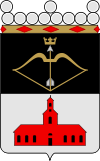Kuopio
| Kuopio | |||
|---|---|---|---|
| — City — | |||
| Kuopion kaupunki | |||
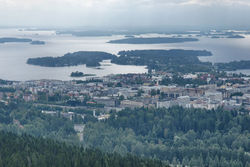 |
|||
|
|||
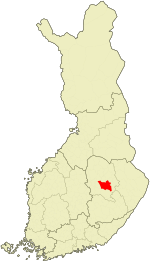 |
|||
| Coordinates: | |||
| Country | Finland | ||
| Region | Northern Savonia | ||
| Sub-region | Kuopio sub-region | ||
| Settled | 1653 | ||
| Charter | 1775 | ||
| Government | |||
| - City manager | Petteri Paronen | ||
| Area(2010-01-01)[1] | |||
| - Total | 1,728.53 km2 (667.4 sq mi) | ||
| - Land | 1,124.02 km2 (434 sq mi) | ||
| - Water | 604.51 km2 (233.4 sq mi) | ||
| Area rank | 55th largest in Finland | ||
| Population (2010-03-31)[2] | |||
| - Total | 92,649 | ||
| - Rank | 9th largest in Finland | ||
| - Density | 82.43/km2 (213.5/sq mi) | ||
| Population by native language[3] | |||
| - Finnish | 97.8% (official) | ||
| - Swedish | 0.1% | ||
| - Others | 2.1% | ||
| Population by age[4] | |||
| - 0 to 14 | 15.6% | ||
| - 15 to 64 | 68.9% | ||
| - 65 or older | 15.4% | ||
| Time zone | EET (UTC+2) | ||
| - Summer (DST) | EEST (UTC+3) | ||
| Postal code | FI-70100 | ||
| Municipal tax rate[5] | 19.5% | ||
| Website | www.kuopio.fi | ||
Kuopio is a Finnish city and municipality located in the region of Northern Savonia. A population of 92,649[2] makes it the ninth biggest city in the country. The city has a total area of 1,728.53 square kilometres (667.39 sq mi), of which 604.51 km2 (233.40 sq mi) is water[1] and half forest. The population density is only 82 /km2 (210 /sq mi), but the city's urban areas are populated very densely (urban area: 1 617.6 /km²[6]), nationally second only to capital Helsinki (urban area: 1 690.0 /km²[6])[7]. The population of the entire Kuopio region is 119,472.[8]
Kuopio was founded in 1653 by Governor Peter Brahe, but the official date is recognized as November 17, 1775, when King Gustav III of Sweden ordered the establishment of the city of Kuopio. The municipality of Vehmersalmi joined the city of Kuopio on January 1, 2005 like the municipality of Kuopion maalaiskunta in 1969 and the municipality of Riistavesi in 1973. Karttula will join Kuopio in 2011[9].
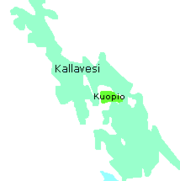
The city is surrounded by lake Kallavesi, and several parts of it are built on islands. Kuopio's ample waterfronts and islands are also utilized in the Saaristokaupunki (lit. Archipelago city) -project, the biggest residential area currently being built in Finland[10]. Saaristokaupunki will accommodate a total of 14,000 inhabitants in 2015. All houses will be situated no more than 500 meters from the nearest lakeshore[11].
Kuopio is known for its association with a national delicacy, Finnish fish pastry (Kalakukko), and the dialect of Savo, as well as the hill of Puijo and the Puijo tower. Besides being a very popular outdoor recreation area, Puijo serves also as a stage for a yearly World Cup ski jumping competition.
The city has a nationally unique feature in its street network, where every second street is practically a pedestrian and cycle street[12], so called "rännikatu" (lit. rain gutter street). These streets provide pedestrians a calm environment aside from the main street traffic[13]. This setup dates back all the way to 1776 and the first town plan by Pehr Kjellman. Originally rännikatu, gränd (in Swedish) were created as a fire barrier to prevent a possible fire escalating in a city mostly built with wood.[14]
The Finnish Orthodox Church is headquartered in Kuopio, where its primate, archbishop of Karelia and all Finland Leo (Makkonen) is seated. The largest church of Finland, Evangelical Lutheran Church has a diocese in Kuopio, which is shepherded by bishop Wille Riekkinen.
Transport connections to Kuopio include Pendolino trains and air service from Kuopio Airport with Finnair, Blue1 and Finncomm (domestic, to Helsinki-Vantaa), and airBaltic (international, to Riga[15]).
| Employer | Staff |
|---|---|
| City of Kuopio | 5 905 |
| Kuopio University Hospital | 3 898 |
| University of Eastern Finland | 1 732 |
| PeeÄssä Co-op | 734 |
| Savo Consortium for Education | 706 |
| Niuvanniemi Hospital | 629 |
| Itella | 553 |
| ISS A/S | 490 |
| Savonia University of Applied Sciences | 439 |
| Honeywell | 370 |
| Keskisuomalainen | 296 |
| Kesko | 296 |
| Tieto | 288 |
| OP-Pohjola Group | 265 |
| Lemminkäinen Group | 263 |
Contents |
Name
There are several explanations behind the name Kuopio. The first is that in the 16th century, a certain influential person named Kauhanen in Tavinsalmi changed his name to Skopa and the people's pronunciation was Coopia and finally Cuopio. The second explanation is that it comes from the verb kuopia, meaning when, for example, a horse paws the ground with its hoof. A third theory is that it came from a certain Karelian man's name Prokopij, from Ruokolahti in the Middle Ages.[17]. This is the most probable explanation, supported by the Research Institute for the Languages of Finland.
Education and business
| University | Students |
|---|---|
| University of Eastern Finland | 6 229[18] |
| Savonia University of Applied Sciences | 5 000[19] |
| HUMAK University of Applied Sciences | ~150 |
| Sibelius Academy | ~100 |
Kuopio has always been a city of education. Some of the first schools offering education in Finnish (such as the School for the Blind in 1871, and the Trade School in 1887) were established in Kuopio. Currently the most important institutions are the University of Eastern Finland, the Savonia University of Applied Sciences, Vocational College of Northern Savonia and the Kuopio department of the Sibelius Academy.
Kuopio is known as a strong center of health (e.g. it has the biggest yearly enrollment rate of medical students in Finland), pharmacy, environment, food & nutrition (all legalized Clinical and Public Health Nutritionists in Finland graduate from the University of Eastern Finland), safety (education in Emergency Services is centered in Kuopio[20]) and welfare professions, as the major organisations University of Kuopio, Savonia University of Applied Sciences and Technopolis Kuopio are particularly oriented to those areas.
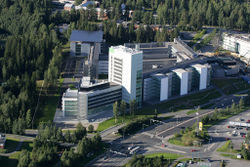
There are about 4,200 enterprises in Kuopio[16], of which approximately 180 are export companies[21]. These provide about 45,000 jobs[21].
People and culture
Kuopio is known as the cultural center of Eastern Finland. A wide range of musical (from kindergarten to doctorate-level studies) and dance education is available and the cultural life is active. Notable events include ANTI – Contemporary Art Festival, Kuopio Dance Festival, Kuopio Rockcock, Kuopio Wine Festival and Finland Ice Marathon. A notable place, however, to enjoy the local flavor of Kuopio life and food is Sampo, a fish restaurant loved by locals and tourists as well.
In Finland the inhabitants of Kuopio have a special reputation: they are known as jovial and verbally joking. Within the Savo culture, the onus is placed on the listener to interpret the story. People of Kuopio region and Eastern Finland have always had many health problems and the mortality has been higher than on an average in Finland. Because of this, Eastern Finland has been a sweetspot for Public Health studies. The North Karelia Project by the University of Kuopio in coordination with the National Public Health Institute and the World Health Organization, beginning in the 1970s was one of its first steps towards world class research.
During the 2000s, Kuopio has placed very well in a number image, popularity and city-attractiveness surveys. In 2007 it was placed third, behind Tampere and Oulu.
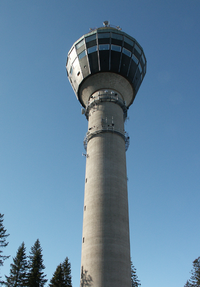
Kuopio is the seat of the Finnish Orthodox Church. This is an autonomous cell within the autocephalous jurisdiction of the Patriarchate of Constantinople. It is the only mainstream Orthodox faction to celebrate Easter on the Latin date. The late Archbishop Paul had been successful in producing literature of popular theology.
The town is also home to the first Burmese Buddhist monastery in Finland, named the Buddha Dhamma Ramsi monastery.[22]
Notable persons
|
|

Sports in Kuopio
Kuopio bid for the 2012 Winter Youth Olympics, a youth sports festival in the tradition of the Olympics. It became a finalist in November 2008, but ultimately lost to Innsbruck, Austria. Kuopio's image as a small city with a large University and many active young people was considered a model of what the International Olympic Committee seeks for the Games.[23]
- KalPa (ice hockey)
- KuPS (football)
- Puijon Hiihtoseura (skiing, ski jumping, nordic combined, biathlon)
- Puijon Pesis (pesäpallo)
- Kuopion Reippaan voimistelijat (gymnastics)
- Finland Ice Marathon (ice skating event)
- Kuopio Steelers (american football)
International relations
Twin towns — Sister cities
Kuopio is twinned with:
References
- Notes
- ↑ 1.0 1.1 "Area by municipality as of 1 January 2010" (in Finnish and Swedish) (PDF). Land Survey of Finland. http://www.maanmittauslaitos.fi/sites/default/files/pinta_alat_kunnittain_01012010.pdf. Retrieved 23 November 2010.
- ↑ 2.0 2.1 "Population by municipality as of 31 March 2010" (in Finnish and Swedish). Population Information System. Population Register Center of Finland. http://www.vrk.fi/vrk/files.nsf/files/ACFC13B2F489698CC22577030039BD73/$file/20100331.htm. Retrieved 13 April 2010.
- ↑ "Population according to language and the number of foreigners and land area km2 by area as of 31 December 2008". Statistics Finland's PX-Web databases. Statistics Finland. http://pxweb2.stat.fi/Dialog/varval.asp?ma=060_vaerak_tau_107_fi&ti=V%E4est%F6+kielen+mukaan+sek%E4+ulkomaan+kansalaisten+m%E4%E4r%E4+ja+maa%2Dpinta%2Dala+alueittain++1980+%2D+2008&path=../Database/StatFin/vrm/vaerak/&lang=3&multilang=fi. Retrieved 29 March 2009.
- ↑ "Population according to age and gender by area as of 31 December 2008". Statistics Finland's PX-Web databases. Statistics Finland. http://pxweb2.stat.fi/Dialog/varval.asp?ma=050_vaerak_tau_104_fi&ti=V%E4est%F6+i%E4n+%281%2Dv%2E%29+ja+sukupuolen+mukaan+alueittain+1980+%2D+2008&path=../Database/StatFin/vrm/vaerak/&lang=3&multilang=fi. Retrieved 28 April 2009.
- ↑ "List of municipal and parish tax rates in 2010". Tax Administration of Finland. 24 November 2009. http://www.vero.fi/download.asp?id=5853;25512. Retrieved 13 January 2010.
- ↑ 6.0 6.1 "Taajamissa asuu 84 prosenttia väestöstä". Statistics Finland. 15 January 2008. http://www.tilastokeskus.fi/ajk/tiedotteet/v2008/tiedote_001_2008-01-15.html. Retrieved 7 January 2009.
- ↑ Kuopio 2015: Jalankulku-, joukkoliikenne- ja autokaupunki. Finland’s Ministry of the Environment. p. 42. ISBN 978-952-11-2852-3. http://www.ymparisto.fi/download.asp?contentid=75863&lan=fi.
- ↑ Kuopion Kaupunkilehti, 19 March 2008, bottom of page 4)
- ↑ "Karttula sulautuu Kuopioon" & "Karttula ja Kuopio yhteen". Savon Sanomat: pp. 1 and 3. 1.7.2008
- ↑ "Kuopion korkein asuinkerrostalo nousi harjakorkeuteen". Suomen Kiinteistölehti: p. 14. 2008-10-16. http://www.kiinteistolehti.fi/uutiset.php?id=4289
- ↑ "Kallaveden syleilyssä". Saaristokaupunki. Kuopio. http://www.saaristokaupunki.fi/index.php?id=5. Retrieved 7 January 2009.
- ↑ WP2: Accessibility, Synthesis Report. Universell utforming. 26 March 2004. p. 14. http://www.universell-utforming.miljo.no/file_upload/wp2_accessibility_synthesis.pdf.
- ↑ Description of the Case Areas. VTT Technical Research Centre of Finland. 2 May 2002. p. 8. http://virtual.vtt.fi/virtual/prompt/case%20areas.pdf.
- ↑ "Napoleon ja Kuopio: Kuninkaiden Kuopio". Memory of Northern Savonia. Museums of Northern Savonia. http://www.pohjois-savonmuisti.fi/verkko_nayttelyt/napoleon_ja_kuopio/kustaa_III.htm. Retrieved 11 January 2009.
- ↑ "Ilmasilta Kuopiosta Latviaan aukeaa". Savon Sanomat: p. 14. 2008-01-25
- ↑ 16.0 16.1 Kuopion työpaikat ja elinkeinorakenne 1.1.2008. Kuopion kaupungin yrityspalvelu. 2008. pp. 1–2. http://www.kuopio.fi/attachments.nsf/Files/040607115432639/$File/elinkeinorakenne.pdf?OpenElement.
- ↑ http://www.kuopio.fi/net.nsf/TD/091003151756754?OpenDocument
- ↑ "Key Data for 2007". University of Kuopio. 2007. http://www.uku.fi/english/data.shtml. Retrieved 9 January 2009.
- ↑ "In English". Savonia University of Applied Sciences. 2009. http://portal.savonia.fi/amk/english. Retrieved 9 January 2009.
- ↑ Emergency Services College
- ↑ 21.0 21.1 "Elinkeinoelämä". City of Kuopio. 7 October 2008. http://www.kuopio.fi/net.nsf/TD/131103132915063?OpenDocument. Retrieved 9 January 2009.
- ↑ http://www.buddhistchannel.tv/index.php?id=71,7596,0,0,1,0
- ↑ Innsbruck and Kuopio Make Final Shortlist For 2012 Youth Olympic Winter Games
- ↑ "List of Twin Towns in the Ruhr Destrict". © 2009 Twins2010.com. http://www.twins2010.com/fileadmin/user_upload/pic/Dokumente/List_of_Twin_Towns_01.pdf?PHPSESSID=2edd34819db21e450d3bb625549ce4fd. Retrieved 2009-10-28.
- ↑ "Opole Official Website – Twin Towns".
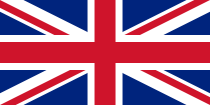
 (in English and Polish) © 2007–2009 Urząd Miasta Opola. http://www.opole.pl/miasto/index.php?option=com_content&task=blogcategory&id=20&Itemid=108. Retrieved 2009-06-18.
(in English and Polish) © 2007–2009 Urząd Miasta Opola. http://www.opole.pl/miasto/index.php?option=com_content&task=blogcategory&id=20&Itemid=108. Retrieved 2009-06-18.
External links
- City of Kuopio – Official website (Finnish) (Swedish) (English) (German)
- KuopioInfo – Various resources about different areas of interest related to Kuopio History and Life (Finnish) (English) (German) (Russian) (Chinese)
- 360° panorama of Kuopio Marketplace
- Savonia University of Applied Sciences (English)
- University of Eastern Finland (English)
- Technopolis Kuopio (Finnish) (English) (Russian)
- Invest in Kuopio -factsheet (English)
- Satellite picture by Google Maps
|
||||||||||||||
|
|||||||||||||||||||||||||||||||||||||||||||||||||||||||||||||||||||||||||||||||||||||||||||||||||||||||
